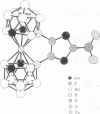Abstract
A novel transition metal complex, Venus flytrap cluster (VFC), is described for the preparation of radio-labeled antibodies. VFC contained 57Co, which was held tightly between the faces of two covalently bridged carborane ligands by cluster bonding of the metal with appropriate ligand orbitals. Anti-carcinoembryonic antigen monoclonal antibody T84.66 was conjugated to 57Co-VFC with full retention of immunological activity. Biodistribution studies in nude mice bearing carcinoembryonic antigen-producing tumors showed excellent tumor localization of 57Co-VFC-T84.66. The accumulation of radionuclide in normal liver was low and independent of dose, which may reflect the stability of the radionuclide complex. These results presage the use of VFC systems for binding transition metals that are clinically useful for radioimmunodiagnosis and radioimmunotherapy.
Full text
PDF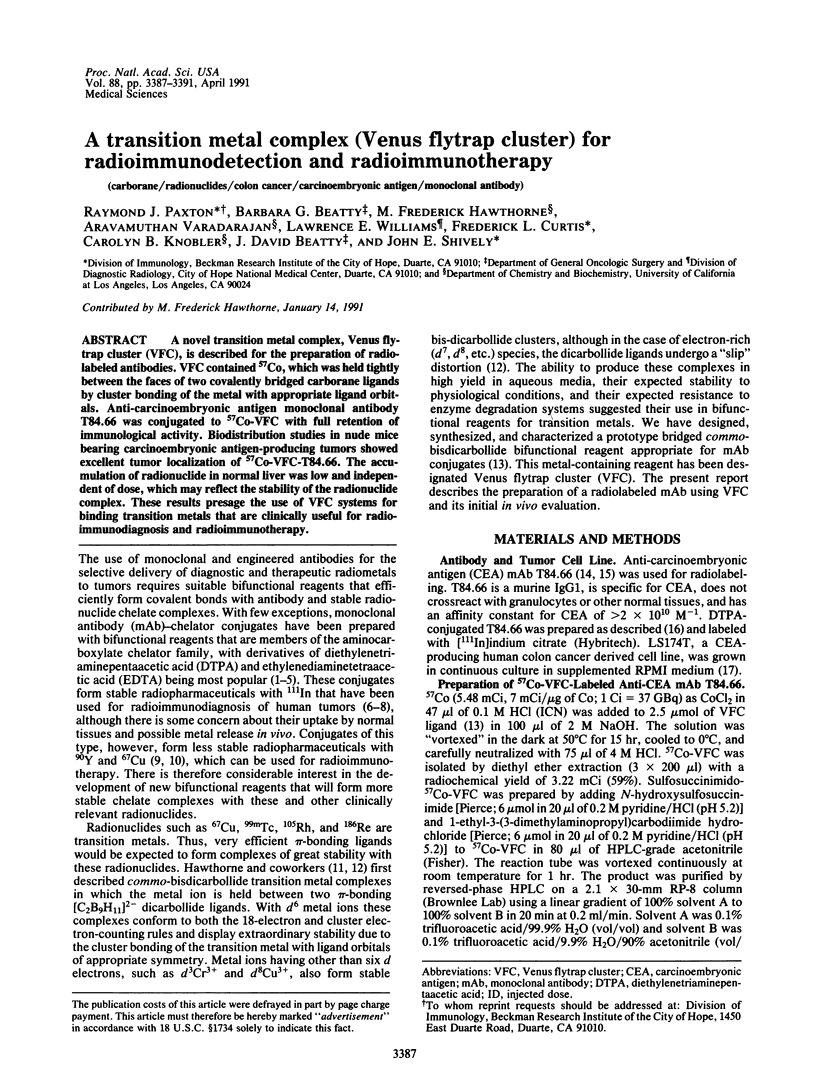

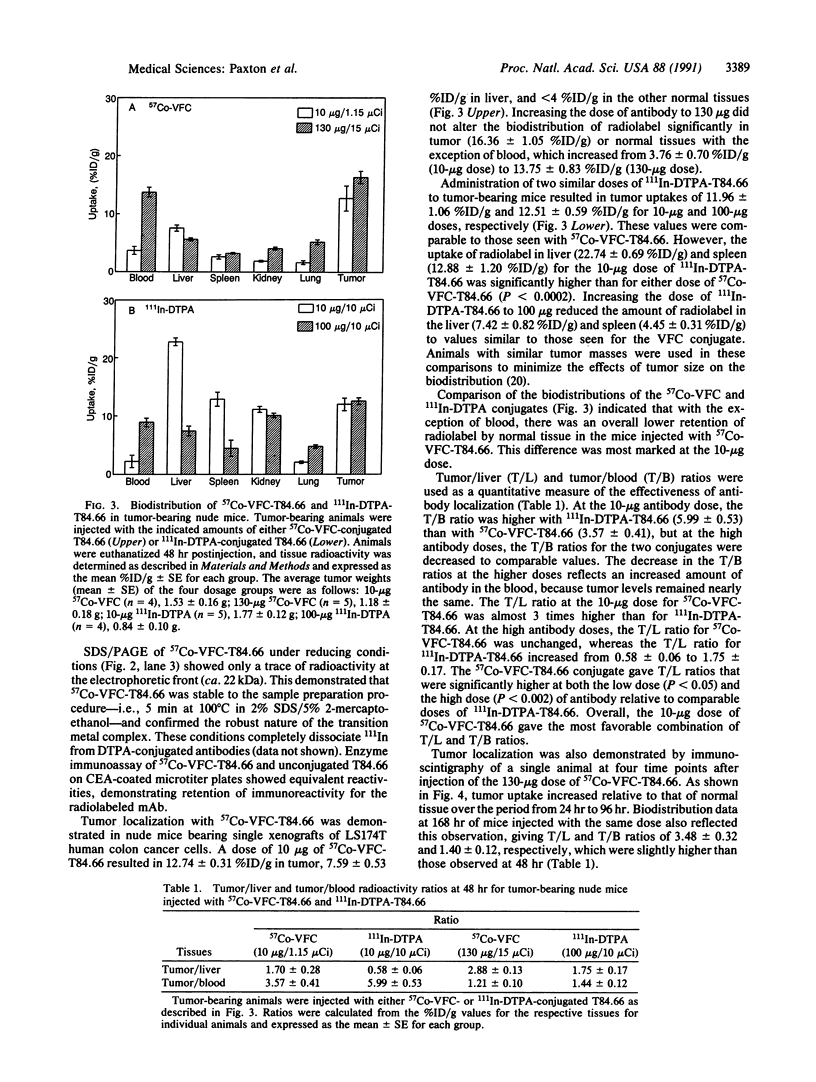
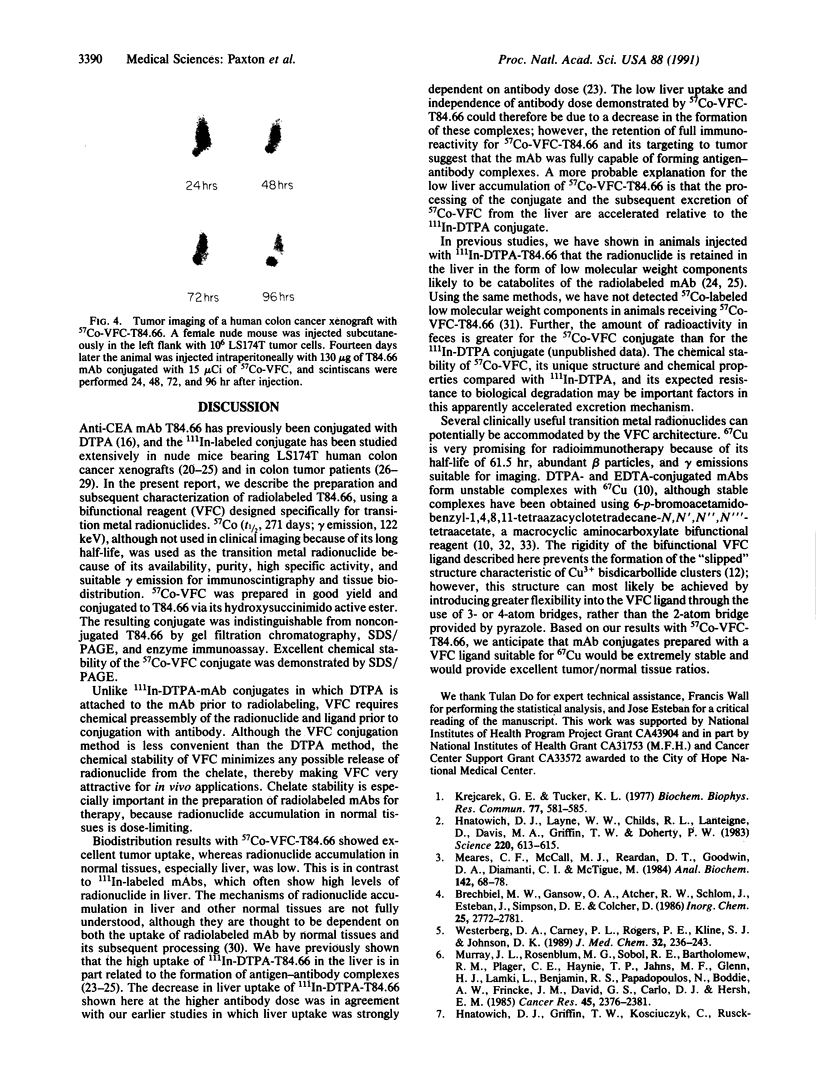
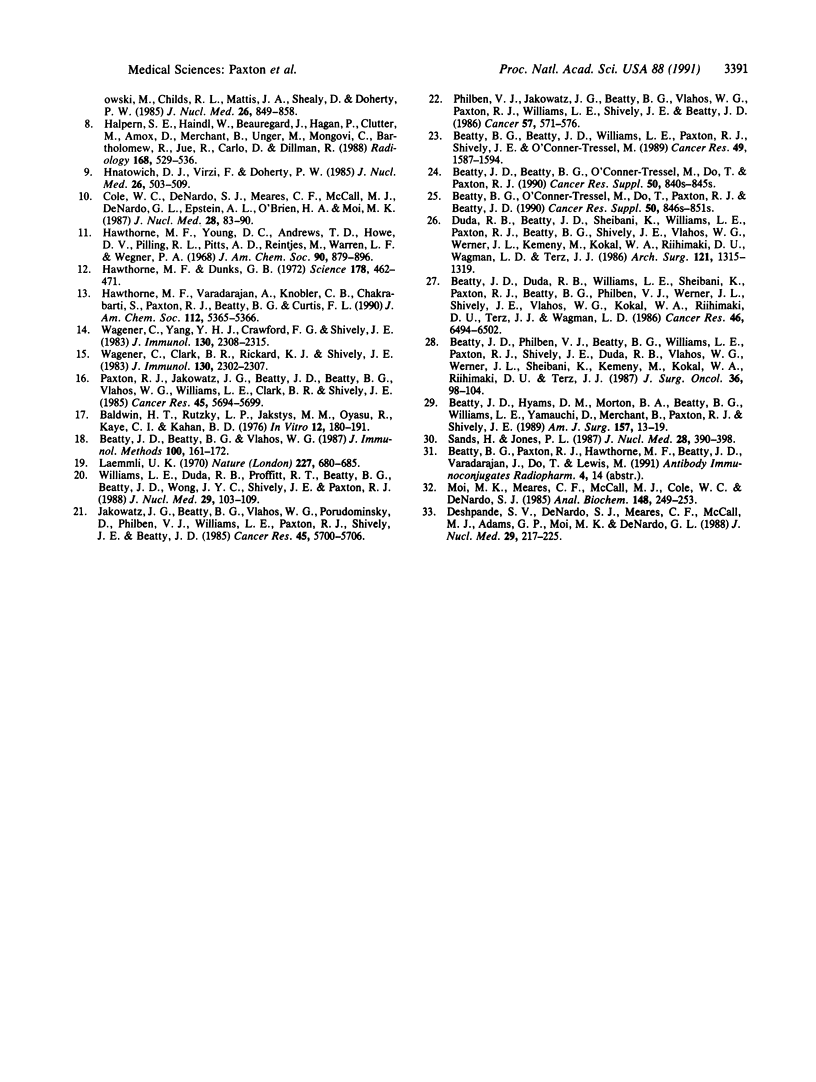
Images in this article
Selected References
These references are in PubMed. This may not be the complete list of references from this article.
- Beatty B. G., Beatty J. D., Williams L. E., Paxton R. J., Shively J. E., O'Connor-Tressel M. Effect of specific antibody pretreatment on liver uptake of 111In-labeled anticarcinoembryonic antigen monoclonal antibody in nude mice bearing human colon cancer xenografts. Cancer Res. 1989 Mar 15;49(6):1587–1594. [PubMed] [Google Scholar]
- Beatty B. G., O'Conner-Tressel M., Do T., Paxton R. J., Beatty J. D. Mechanism of decreasing liver uptake of 111In-labeled anti-carcinoembryonic antigen monoclonal antibody by specific antibody pretreatment in tumor bearing mice. Cancer Res. 1990 Feb 1;50(3 Suppl):846s–851s. [PubMed] [Google Scholar]
- Beatty J. D., Beatty B. G., O'Conner-Tressel M., Do T., Paxton R. J. Mechanisms of tissue uptake and metabolism of radiolabeled antibody--role of antigen: antibody complex formation. Cancer Res. 1990 Feb 1;50(3 Suppl):840s–845s. [PubMed] [Google Scholar]
- Beatty J. D., Beatty B. G., Vlahos W. G., Hill L. R. Method of analysis of non-competitive enzyme immunoassays for antibody quantification. J Immunol Methods. 1987 Jun 26;100(1-2):161–172. doi: 10.1016/0022-1759(87)90186-4. [DOI] [PubMed] [Google Scholar]
- Beatty J. D., Duda R. B., Williams L. E., Sheibani K., Paxton R. J., Beatty B. G., Philben V. J., Werner J. L., Shively J. E., Vlahos W. G. Preoperative imaging of colorectal carcinoma with 111In-labeled anticarcinoembryonic antigen monoclonal antibody. Cancer Res. 1986 Dec;46(12 Pt 1):6494–6502. [PubMed] [Google Scholar]
- Beatty J. D., Hyams D. M., Morton B. A., Beatty B. G., Williams L. E., Yamauchi D., Merchant B., Paxton R. J., Shively J. E. Impact of radiolabeled antibody imaging on management of colon cancer. Am J Surg. 1989 Jan;157(1):13–19. doi: 10.1016/0002-9610(89)90413-3. [DOI] [PubMed] [Google Scholar]
- Beatty J. D., Philben V. J., Beatty B. G., Williams L. E., Paxton R. J., Shively J. E., Duda R. B., Vlahos W. G., Werner J. L., Sheibani K. Imaging of colon carcinoma with 111-indium-labeled anti-CEA monoclonal antibodies (Indacea) prior to surgery. J Surg Oncol. 1987 Oct;36(2):98–104. doi: 10.1002/jso.2930360205. [DOI] [PubMed] [Google Scholar]
- Cole W. C., DeNardo S. J., Meares C. F., McCall M. J., DeNardo G. L., Epstein A. L., O'Brien H. A., Moi M. K. Comparative serum stability of radiochelates for antibody radiopharmaceuticals. J Nucl Med. 1987 Jan;28(1):83–90. [PubMed] [Google Scholar]
- Deshpande S. V., DeNardo S. J., Meares C. F., McCall M. J., Adams G. P., Moi M. K., DeNardo G. L. Copper-67-labeled monoclonal antibody Lym-1, a potential radiopharmaceutical for cancer therapy: labeling and biodistribution in RAJI tumored mice. J Nucl Med. 1988 Feb;29(2):217–225. [PubMed] [Google Scholar]
- Duda R. B., Beatty J. D., Sheibani K., Williams L. E., Paxton R. J., Beatty B. G., Shively J. E., Vlahos W. G., Werner J. L., Kemeny M. M. Imaging of human colorectal adenocarcinoma with indium-labeled anticarcinoembryonic antigen monoclonal antibody. Arch Surg. 1986 Nov;121(11):1315–1319. doi: 10.1001/archsurg.121.11.1315. [DOI] [PubMed] [Google Scholar]
- Halpern S. E., Haindl W., Beauregard J., Hagan P., Clutter M., Amox D., Merchant B., Unger M., Mongovi C., Bartholomew R. Scintigraphy with In-111-labeled monoclonal antitumor antibodies: kinetics, biodistribution, and tumor detection. Radiology. 1988 Aug;168(2):529–536. doi: 10.1148/radiology.168.2.3393677. [DOI] [PubMed] [Google Scholar]
- Hawthorne M. F., Dunks G. B. Metallocarboranes That Exhibit Novel Chemical Features: A virtually unlimited variety of structural and dynamic features are observed in metallocarborane chemistry. Science. 1972 Nov 3;178(4060):462–471. doi: 10.1126/science.178.4060.462. [DOI] [PubMed] [Google Scholar]
- Hnatowich D. J., Griffin T. W., Kosciuczyk C., Rusckowski M., Childs R. L., Mattis J. A., Shealy D., Doherty P. W. Pharmacokinetics of an indium-111-labeled monoclonal antibody in cancer patients. J Nucl Med. 1985 Aug;26(8):849–858. [PubMed] [Google Scholar]
- Hnatowich D. J., Layne W. W., Childs R. L., Lanteigne D., Davis M. A., Griffin T. W., Doherty P. W. Radioactive labeling of antibody: a simple and efficient method. Science. 1983 May 6;220(4597):613–615. doi: 10.1126/science.6836304. [DOI] [PubMed] [Google Scholar]
- Hnatowich D. J., Virzi F., Doherty P. W. DTPA-coupled antibodies labeled with yttrium-90. J Nucl Med. 1985 May;26(5):503–509. [PubMed] [Google Scholar]
- Jakowatz J. G., Beatty B. G., Vlahos W. G., Porudominsky D., Philben V. J., Williams L. E., Paxton R. J., Shively J. E., Beatty J. D. High-specific-activity 111In-labeled anticarcinoembryonic antigen monoclonal antibody: biodistribution and imaging in nude mice bearing human colon cancer xenografts. Cancer Res. 1985 Nov;45(11 Pt 2):5700–5706. [PubMed] [Google Scholar]
- Krejcarek G. E., Tucker K. L. Covalent attachment of chelating groups to macromolecules. Biochem Biophys Res Commun. 1977 Jul 25;77(2):581–585. doi: 10.1016/s0006-291x(77)80018-1. [DOI] [PubMed] [Google Scholar]
- Laemmli U. K. Cleavage of structural proteins during the assembly of the head of bacteriophage T4. Nature. 1970 Aug 15;227(5259):680–685. doi: 10.1038/227680a0. [DOI] [PubMed] [Google Scholar]
- Meares C. F., McCall M. J., Reardan D. T., Goodwin D. A., Diamanti C. I., McTigue M. Conjugation of antibodies with bifunctional chelating agents: isothiocyanate and bromoacetamide reagents, methods of analysis, and subsequent addition of metal ions. Anal Biochem. 1984 Oct;142(1):68–78. doi: 10.1016/0003-2697(84)90517-7. [DOI] [PubMed] [Google Scholar]
- Moi M. K., Meares C. F., McCall M. J., Cole W. C., DeNardo S. J. Copper chelates as probes of biological systems: stable copper complexes with a macrocyclic bifunctional chelating agent. Anal Biochem. 1985 Jul;148(1):249–253. doi: 10.1016/0003-2697(85)90653-0. [DOI] [PubMed] [Google Scholar]
- Murray J. L., Rosenblum M. G., Sobol R. E., Bartholomew R. M., Plager C. E., Haynie T. P., Jahns M. F., Glenn H. J., Lamki L., Benjamin R. S. Radioimmunoimaging in malignant melanoma with 111In-labeled monoclonal antibody 96.5. Cancer Res. 1985 May;45(5):2376–2381. [PubMed] [Google Scholar]
- Paxton R. J., Jakowatz J. G., Beatty J. D., Beatty B. G., Vlahos W. G., Williams L. E., Clark B. R., Shively J. E. High-specific-activity 111In-labeled anticarcinoembryonic antigen monoclonal antibody: improved method for the synthesis of diethylenetriaminepentaacetic acid conjugates. Cancer Res. 1985 Nov;45(11 Pt 2):5694–5699. [PubMed] [Google Scholar]
- Philben V. J., Jakowatz J. G., Beatty B. G., Vlahos W. G., Paxton R. J., Williams L. E., Shively J. E., Beatty J. D. The effect of tumor CEA content and tumor size on tissue uptake of indium 111-labeled anti-CEA monoclonal antibody. Cancer. 1986 Feb 1;57(3):571–576. doi: 10.1002/1097-0142(19860201)57:3<571::aid-cncr2820570329>3.0.co;2-b. [DOI] [PubMed] [Google Scholar]
- Sands H., Jones P. L. Methods for the study of the metabolism of radiolabeled monoclonal antibodies by liver and tumor. J Nucl Med. 1987 Mar;28(3):390–398. [PubMed] [Google Scholar]
- Tom B. H., Rutzky L. P., Jakstys M. M., Oyasu R., Kaye C. I., Kahan B. D. Human colonic adenocarcinoma cells. I. Establishment and description of a new line. In Vitro. 1976 Mar;12(3):180–191. doi: 10.1007/BF02796440. [DOI] [PubMed] [Google Scholar]
- Wagener C., Clark B. R., Rickard K. J., Shively J. E. Monoclonal antibodies for carcinoembryonic antigen and related antigens as a model system: determination of affinities and specificities of monoclonal antibodies by using biotin-labeled antibodies and avidin as precipitating agent in a solution phase immunoassay. J Immunol. 1983 May;130(5):2302–2307. [PubMed] [Google Scholar]
- Wagener C., Yang Y. H., Crawford F. G., Shively J. E. Monoclonal antibodies for carcinoembryonic antigen and related antigens as a model system: a systematic approach for the determination of epitope specificities of monoclonal antibodies. J Immunol. 1983 May;130(5):2308–2315. [PubMed] [Google Scholar]
- Westerberg D. A., Carney P. L., Rogers P. E., Kline S. J., Johnson D. K. Synthesis of novel bifunctional chelators and their use in preparing monoclonal antibody conjugates for tumor targeting. J Med Chem. 1989 Jan;32(1):236–243. doi: 10.1021/jm00121a042. [DOI] [PubMed] [Google Scholar]
- Williams L. E., Duda R. B., Proffitt R. T., Beatty B. G., Beatty J. D., Wong J. Y., Shively J. E., Paxton R. J. Tumor uptake as a function of tumor mass: a mathematic model. J Nucl Med. 1988 Jan;29(1):103–109. [PubMed] [Google Scholar]



